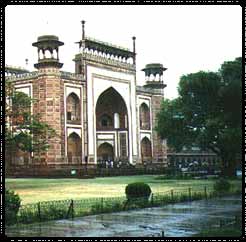|
|
Purpose
 In
this courtyard stand the main gateway to the Taj and its gardens, a
massive portal that opens to the south. Detached gateways were long a
traditional feature of Muslim architecture and could be found fronting
tombs and mosques throughout the East. Symbolically to the Muslim, such
an entrance way was the gate to paradise. Metaphysically, it represented
the transition point between the outer world of the senses and the inner
world of the spirit.
In
this courtyard stand the main gateway to the Taj and its gardens, a
massive portal that opens to the south. Detached gateways were long a
traditional feature of Muslim architecture and could be found fronting
tombs and mosques throughout the East. Symbolically to the Muslim, such
an entrance way was the gate to paradise. Metaphysically, it represented
the transition point between the outer world of the senses and the inner
world of the spirit. Structure
Made of red sandstone, this 150 ft. wide and nearly 100 ft. high, gateway consists of a lofty central arch with double storeyed wings on either side. Octagonal towers are attached to its corners which are surmounted by broad impressive open domed kiosks. The most important feature of the gateway however is the introduction of a series of eleven attached chhatris (umbrellas) with marble cupolas, flanked by pinnacles, above the central portal on the north and south sides. A heavy door at the base is made from eight different metals and studded with knobs. Inside are countless rooms with hallways that wind and divide in such apparent abandon that they seem intentionally built to confuse; perhaps they were, for they have remained unused for three centuries and their purpose has long confounded the experts. Within the archway of this majestic entrance, there is a large chamber with a vaulted roof.
Decoration
The gateway is richly embellished. Of particular note are the floral arabesques fashioned from gemstones and inlaid in while marble which decorate the spandrels of the arches. Also impressive are the inlaid black marble inscriptions that frame the central vaulted portal or iwan. These passages are excerpts from the Koran, which is considered by Muslims to be the word of God as revealed to Mohammed. It is here that Shah Jehan's calligraphers have performed an amazing optical trick : the size of the lettering that runs up and over the arch appears to be consistent from top to bottom. This illusion was created by gradually heightening the size of the letters as their distance from the eye increased; from the ground the dimensions seem the same at every point. This ingenious trompe l'oeil effect is used with equal success on the main doorway of the Taj itself. It is said that upon first beholding the Taj through this gateway it will look small and far away, as if built in three-quarter scale. This is another optical trick. As one approaches, the illusion turns into another illusion: the building begins to grow, and continues to grow until, when the base is reached, it looms colossal. The dome especially seems to expand as one comes near, almost as if it were being slowly inflated.


